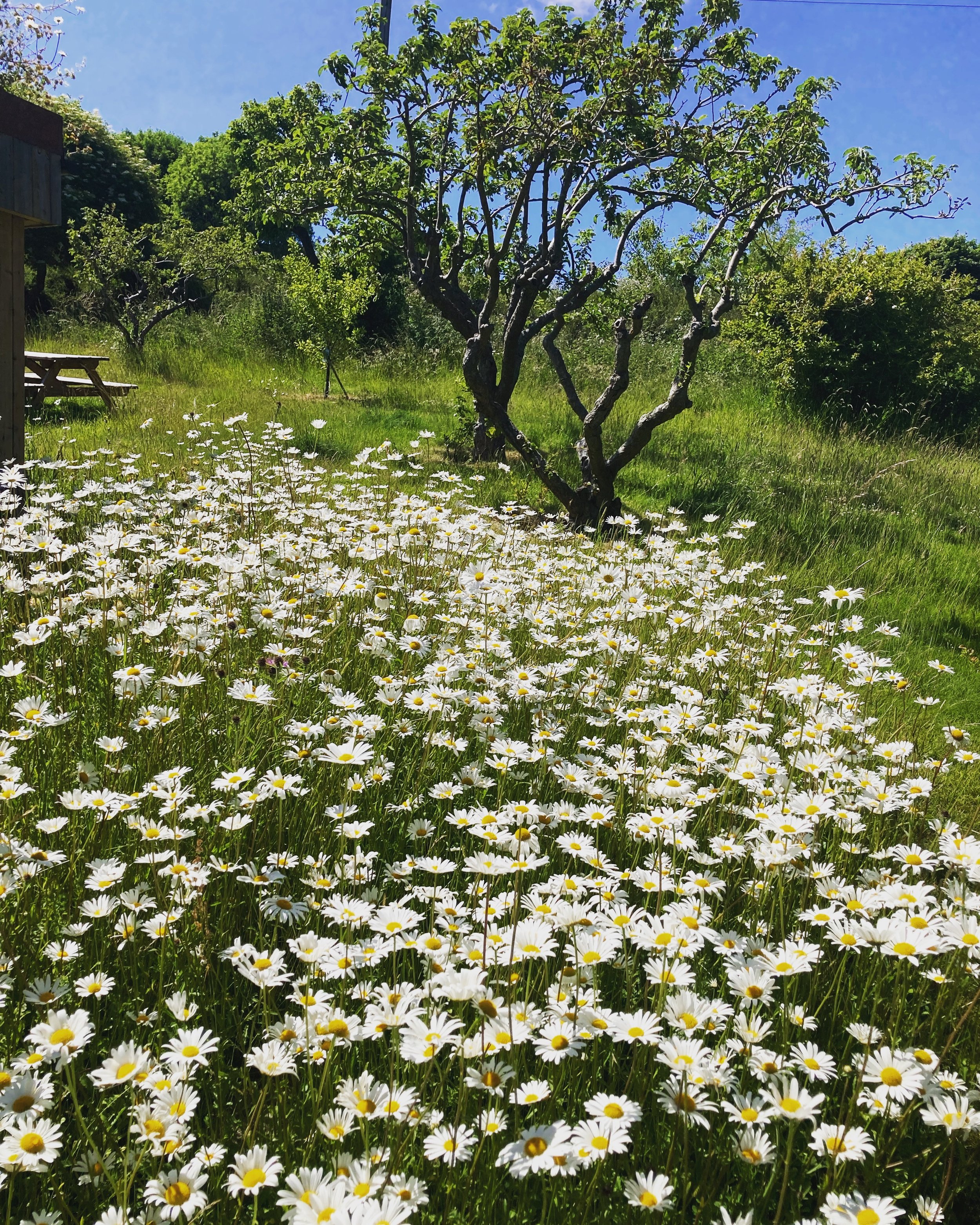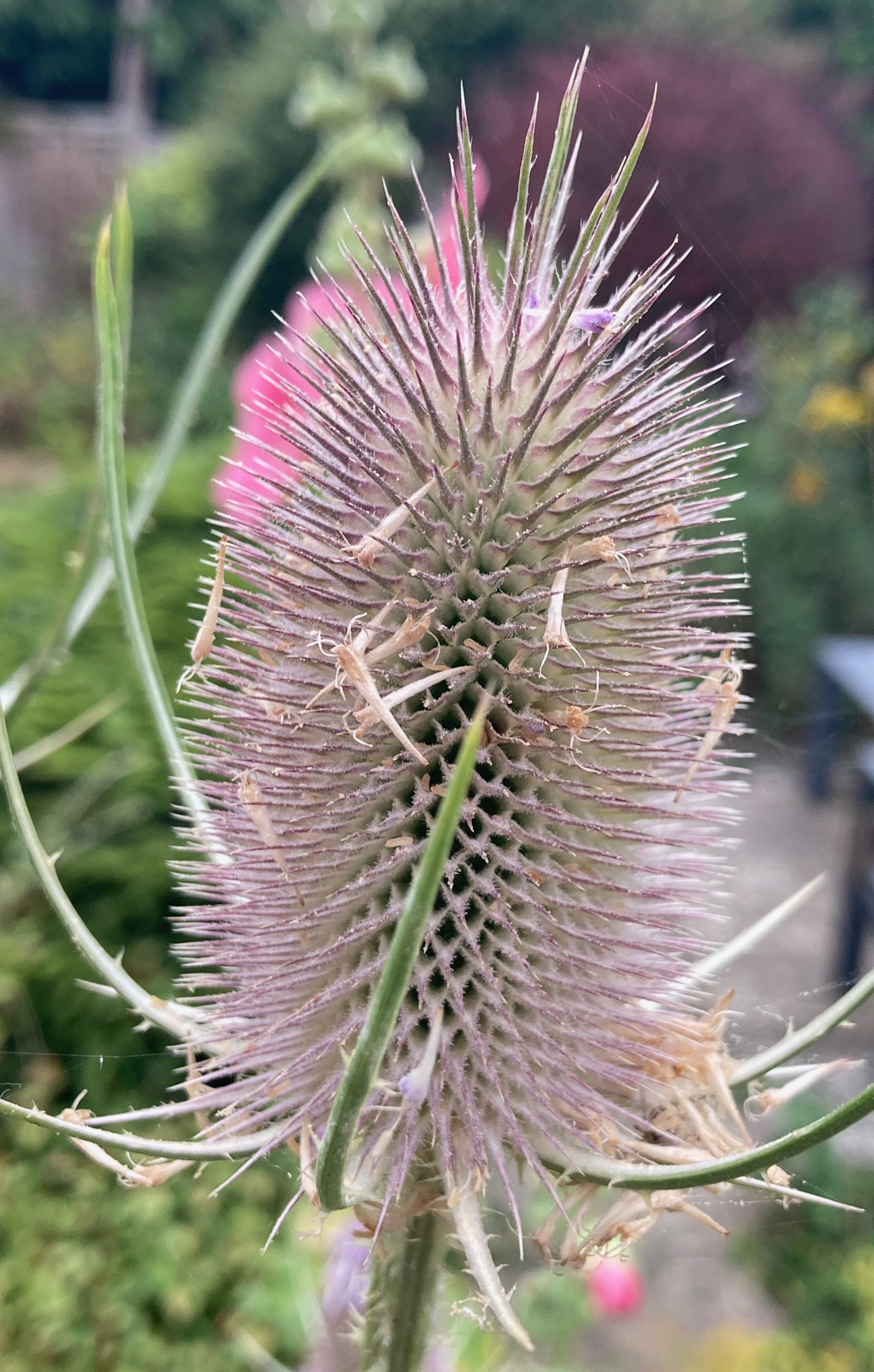Wildflowers for the Garden
Wild carrot has a single crimson flower in the centre of the umbellifer
All the best garden designers incorporate native wildflowers into their planting schemes. It’s a great idea as they look fantastic in flowerbeds, are long lasting, and need little maintenance. Even better they are great for pollinators and other wildlife. It isn’t always about introducing new plants by sowing seeds, plug plants or larger plants. It’s often just about allowing plants to grow by not weeding or mowing them.
Here are some of my favourite wildflowers that are growing at Chalkhill
Sweet violet (Viola odorata) is one of my favourite signs of spring. Flowering from late February to May the 5 petalled flowers, which are often dark purple, can also be light blue or white. This low-level plant is from the woodland so likes some shade and will spread so looks great in the lawn, path edges or the front of borders. At Chalkhill sections of the lawn have large patches of Sweet violet. Early spring flowers such as violets are an important source of nectar for early emerging pollinators such as queen bumblebees searching for new nest sites.
Red deadnettle (Lamium purpureum) is a much more delicate plant than stinging nettles and it doesn’t sting. In flower from March through to November this plant looks pretty in a shaded border with its pale to dark pink flowers and purple toned leaves. Red deadnettle will stay small and close to the ground in an exposed site and can grow up to 50cm in a damp hedgerow. It pops up regularly in exposed sections of soil at Chalkhill where I encourage it to stay. The leaves of dead nettles are food for several species of moth caterpillars, such as the Tiger moth, and the flowers provide nectar to Red Mason bees and some bumblebee species.
Cow parsley (Anthriscus sylvestris) is a tall plant with bright green leaves and delicate umbellifer flowers. A welcome sign of spring when it flowers from late April until June. Naturally found at a woodland edge or in hedgerows, this plant looks great along garden edges where it likes the shade. The hedgerows outside Chalkhill are full of this lovely plant, so 2 years ago I collected seed. Cow parsley is biennial, meaning it produces leaves in the first year of growth and flowers in the second, so I’m hoping for flowers this year. An attractive nectar source for the Orange-tip butterfly and a variety of hoverfly species
Ox eye daisy (Leucanthemum vulgare), also known as Moon daisy. Flowering from May to September this huge daisy will grow in any soil and likes the sun. Ox eye daisies look great dotted in a flowerbed, as a swath of white flowers in a patch of the garden and in a meadow. When digging out for a shed base resulted in a large pile of subsoil I sowed wildflower seeds 3 years ago. Last year the bank was awash with Ox eye daisies and this year I can see even more coming up in the flowerbeds. Ox eye daisies provide nectar for a wide variety of pollinators including hoverflies.
Broad-leaved everlasting sweat pea (Lathyrus latifolius). A sweet pea that re-appears every year! It doesn’t have the scent of annual sweet peas but its shares its beautiful flowers, usually in a vibrate rose colour. Flowering from June throughout the summer, this robust climbing plant looks great growing on a fence or wall. It likes the sun and poor soil, and when conditions are good will spread easily, though won’t travel far from its parent. After enviously admiring a neighbour’s plants I sowed seeds 2 years ago and planted them out last year. I’m keeping my fingers crossed for flowers this year. A food plant of the Long tailed blue butterfly, which is increasingly being seen in the South of England due to climate change.
Common Knapweed (Centaurea nigra) likes the sun and well-drained soil. With a flower like a thistle its leaves are certainly not, they are small, linear and finely hairy. This delicate plant flowers from June to September. It looks great in tall grass, and also works well in a border where it will retain its shape in winter. At Chalkhill these arrived in the same wildflower seed mix as the Ox eye daisies, and they look great together. Common Knapweed is an excellent source of nectar for many pollinators, especially butterflies. In Autumn and Winter seedheads provide seed for finches.
Wild carrot (Daucus carota) is also known as Queen Anne’s Lace due to its delicate lacy appearance. A white umbellifer shaped flower, sometimes tinged pink. In the centre of each flower there’s a single crimson flower. Flowers from June until very late Autumn. Another biennial Wild carrot looks great in a sunny garden border. I’m happy to say Wild carrot has found its own way to Chalkhill and has happily embedded itself into the flowerbeds. Frequented by hoverflies such as the Marmalade hoverfly, which also eats aphids. It also provides seeds for birds such as goldfinches in winter
tand out
Teasel (Dipsacus fallonum) is another tall plant. Its tiny purple flowers are compacted onto a curved spike. The actual flowers last just a short time during July to September but the head lasts for months and looks striking right through the winter. Teasel likes the sun and will grow well in heavy damp soil as well as dry poor soil. It looks great in a border or a wildflower meadow. One of my all time favourite plants I have nurtured Teasel from seed and planted seedlings out last year around the pond, so am looking forward to flowers this year. Teasel seeds are loved by Goldfinches and other birds in the winter.
For more ideas on native plants for your garden to support pollinators visit chalkhillrewilding.co.uk









